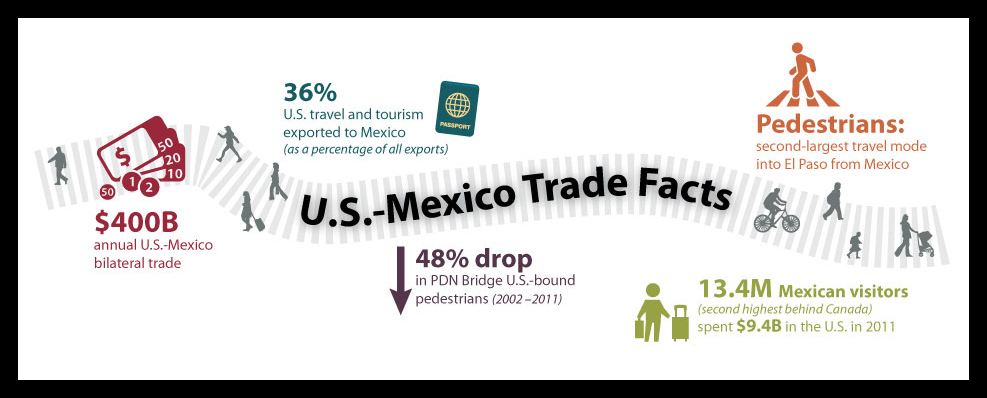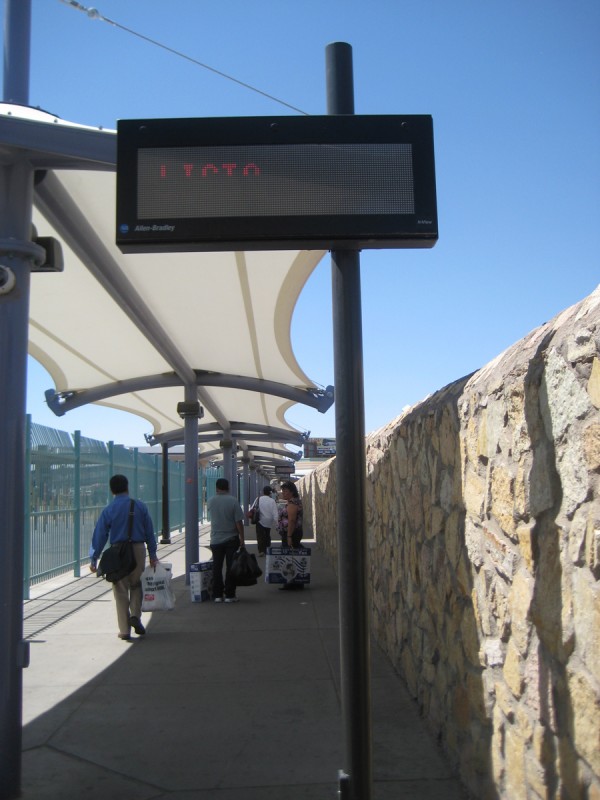Pedestrians are traveling less often over the Paso del Norte Bridge, negatively impacting local businesses. Why? TTI researchers are working to find the answer.
What’s the Problem?
Supporting the economic development of both Ciudad Juárez and El Paso, the Paso del Norte (PDN) Bridge is one of the busiest border pedestrian crossings between Texas and Mexico. Over the last several years, pedestrian traffic has decreased significantly, partially due to long wait times at border crossings. For instance, the PDN served almost 7.3 million northbound pedestrians in 2002 but only 3.8 million northbound pedestrians in 2011. Though this is likely a primary cause, other factors might include concerns over security issues, peso devaluations, and migration in response to violence. Why pedestrians are choosing to reduce their travel, however, is not yet well understood. While prior research studies have examined motorized traffic, little research has studied pedestrian travel choices in detail. Besides the pedestrians themselves, others impacted by reduced foot traffic over the PDN Bridge include companies suffering losses in productivity and revenue, the commercial retail sector of El Paso, and the general public in both communities north and south of the border.
Understanding why PDN Bridge pedestrians have reduced their travel can help U.S. stakeholders mitigate financial losses and encourage economic development along the border with Mexico.
What’s the Solution?
Understanding changes in pedestrian traffic trends is critical for retailers to efficiently conduct business. It can also help authorities proactively address border-crossing operations, promote economic development, and meet the mobility, safety, security, personal and public health, and socio-economic needs of citizens. First, however, data must be collected and analyzed to define those trends. Researchers can then determine why people make certain travel choices and provide recommendations for mitigating negative influences behind that decision-making process.
How Was the Study Done?
Researchers with the Texas A&M Transportation Institute’s (TTI’s) Center for International Intelligent Transportation Research (CIITR) have divided this project into two phases. Phase 1 developed a conceptual framework and determined data sources for identifying the reasons for pedestrian behaviors. After synthesizing influential factors, issues, and concepts related to pedestrian cross-border analysis/modeling, researchers determined characteristics and operational details unique to the PDN Bridge. They then created a data inventory and developed a local travel survey (to serve as the study’s primary data source) of PDN Bridge pedestrians. Secondary data sources were also explored. In phase 2 of the project, researchers will implement the survey, conduct an in-depth analysis of the results, and build a robust model for stakeholders to use in better understanding pedestrian travel choices.
Research Benefits
“The drop in international bridge pedestrian traffic is troubling to local business owners and officials alike,” says City of El Paso Program Manager Kyle Ibarra. “Building on TTI’s research, we can revitalize our local economy and create a host of programs and projects to further local economic development and mobility initiatives.”
More thoroughly comprehending and managing pedestrian travel can
- improve economic opportunity for local businesses,
- help reduce border congestion (yielding cleaner air for the surrounding communities),
- make pedestrian travel—the cleanest mode of transportation—more appealing (thereby positively impacting regional mobility, sustainability, and health), and
- enhance the overall quality of life for local populations.
This project’s results will provide an empirical base upon which entrepreneurs and policymakers can, respectively, develop business strategies and legislation to improve cross-border foot traffic and, potentially, achieve the benefits outlined above. Stakeholders in other, similar border communities can use the model created by this research team to examine local pedestrian behaviors. Ultimately, the project’s findings will empower border communities with the information they need to develop policies that ensure regional economic and environmental sustainability.
Project Title
Toward Understanding the Pedestrian Travel on the Paso del Norte BridgeProject Number
186042-00009
Project Sponsor(s)
Center for International Intelligent Transportation Research
Project Category
Human & Behavioral Studies
Project Termination Date
08/31/2012
Project Publications
For More Information
Ipek Sener, Ph.D.
Assistant Research ScientistTravel Forecasting – Suite 455
Texas A&M Transportation Institute
The Texas A&M University System
505 E Huntland Dr.
Austin, TX 78752
Ph. (512) 407-1119
i-sener@tti.tamu.edu
Rafael Aldrete, Ph.D.
Senior Research ScientistResearch and Implementation - San Antonio/El Paso Region – Suite 151
Texas A&M Transportation Institute
The Texas A&M University System
4050 Rio Bravo Dr.
El Paso, TX 79902
Ph. (915) 532-3759
r-aldrete@tamu.edu
